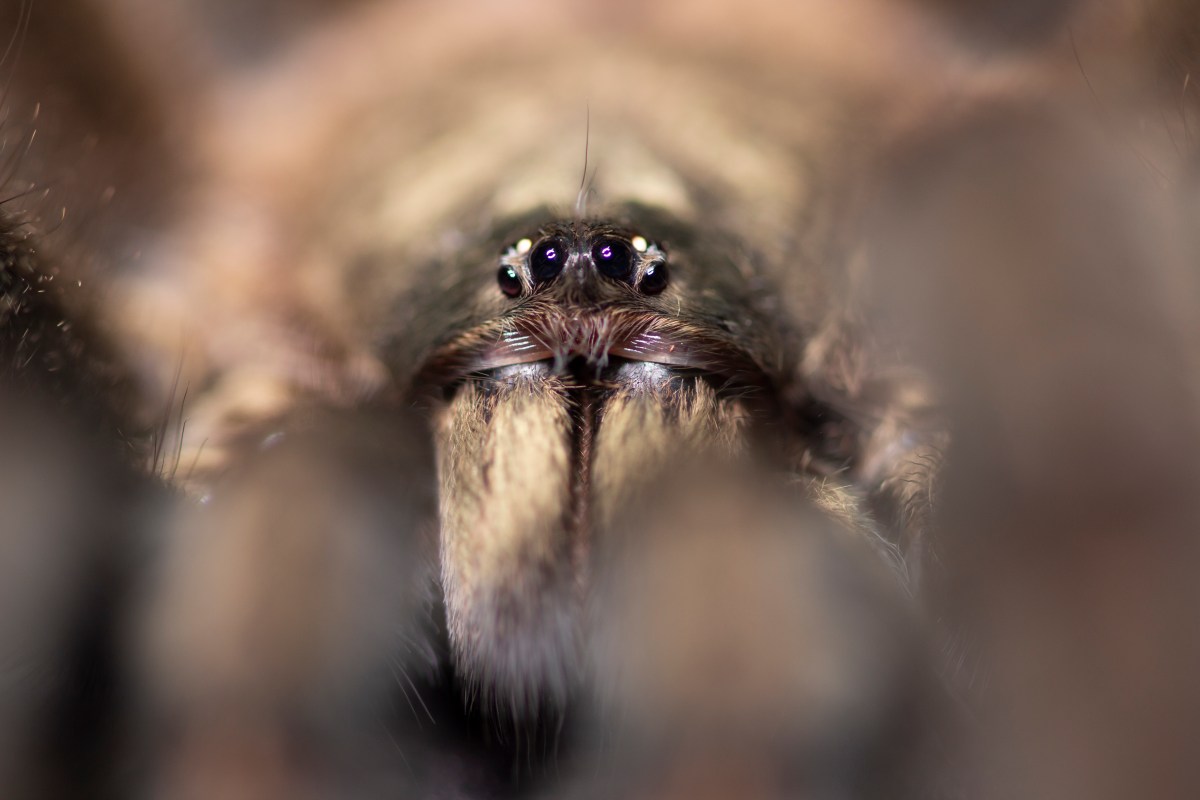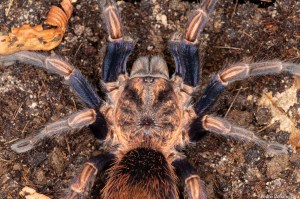Protecting The ‘Satan’ Tarantula and Other Lovable Giant Spiders
9:01 minutes

Esta historia está disponible en español. This story is available in Spanish.
A team of scientists in Ecuador is on a mission to find and describe species of an understudied, often unpopular group of critters: mygalomorphs, a group of large, stocky spiders that includes tarantulas. In late 2023, two of these researchers published a paper in the journal ZooKeys describing two new-to-science tarantula species, including one named Psalmopoeus satanas—affectionately called the “Satan tarantula” because of its erratic behavior.

Tarantulas are understudied in Ecuador, and there are many species left to describe. They’re also threatened by mining, agriculture, and the illegal pet trade. That’s what led Pedro Peñaherrera-R., a researcher at Universidad San Francisco de Quito to found the Mygalomorphae Research Group. Its members are working to describe these spiders and secure conservation protections before they possibly disappear.
Producer Rasha Aridi talks with Peñaherrera-R. and his co-author and fellow group member Roberto José León about how the Satan tarantula earned its name, how they discover and classify spiders, and why we should all show spiders a little more love.
Invest in quality science journalism by making a donation to Science Friday.
Pedro Peñaherrera is founder of the Mygalomorphae Research Group at the Universidad San Francisco de Quito in Ecuador.
Roberto Jose León is a biology student and member of the Mygalomorphae Research Group at the Universidad San Francisco de Quito in Ecuador.
IRA FLATOW: This is Science Friday. I’m Ira Flatow here with SciFri producer Rasha Aridi, who has a story about a critter that she has come to love, ooh. Hi, Rasha.
RASHA ARIDI: Hey, Ira. Yeah, so this critter is small. It’s pretty fuzzy. And it’s kind of shy.
IRA FLATOW: Are we playing 20 questions here?
RASHA ARIDI: Yes, actually. How about a hint? It has really cute eyes, eight of them, in fact.
IRA FLATOW: Cute eyes, that magic number eight. It’s fuzzy, so I’m guessing it’s not an octopus.
RASHA ARIDI: It’s not an octopus for once, actually. I’m talking about tarantulas, everybody’s favorite critter or so I would like to believe.
IRA FLATOW: Especially if you’re James Bond, but that’s another story. Rasha, take it away.
RASHA ARIDI: Spider scientists in Quito, Ecuador are on a mission to find and describe new species of tarantulas that live all over Ecuador. In a recent study, they described two species that are brand new to science, including one that’s affectionately named the Satan spider.
I spoke with the authors of the spider-y study, researchers at the Mygalomorphae Research Group at the University of San Francisco in Quito, Ecuador. Pedro Peñaherrera is the founder of the group, and Roberto José León is a biology student and group member. Roberto and Pedro, welcome to Science Friday.
ROBERTO JOSÉ LEÓN: Thank you for having us.
PEDRO PEÑAHERRERA: Thanks.
RASHA ARIDI: So Roberto, I’m really intrigued by this Satan spider that you recently described. How did it even get its name?
ROBERTO JOSÉ LEÓN: All right. So the spider was originally in this like bamboo fence thing. And we started digging, like chopping out pieces of bamboo, so that we can get the spider. And instead of just crawling out and running away, like most spiders would do, the spider just decided it would fling itself onto whatever was there. And spiders have really poor vision, so it definitely had no idea what it was jumping to. But it jumped directly at one of my friend’s chest.
RASHA ARIDI: [LAUGHS]
ROBERTO JOSÉ LEÓN: It was quite funny.
RASHA ARIDI: That’s amazing. So after you caught this tarantula, you brought it back to the lab. How do you go about classifying it?
ROBERTO JOSÉ LEÓN: There’s basically three different ways that you can classify a new species. You can either have morphological characteristics, which are basically the features of its body, and how its body functions, its physiology, and all of these different aspects. You have the genetic aspects. Based on the amount of mutations and differences to other spiders in certain genes, you could classify as different species as belonging to different lineages. Then there is basically the ecological aspect of this where you can differentiate two species by several different ecological characteristics.
One of the main would be basically arboreal spiders have hairier feet because they use these feet, these little hair-like structures to stick onto things. So the arboreal spiders not only have this different ecological niche they have to fill in. And they also have these structures that follow this niche. And we use all three of those things to determine if that spider is or isn’t a new species.
RASHA ARIDI: So this very special Satan spider that you found, what characteristics did it have that was special?
ROBERTO JOSÉ LEÓN: When we use these morphological characteristics, we tend to use the lock-and-key hypothesis. You can basically infer whether something is or isn’t a new species if you have the male and female of that species, and you can tell because of the characteristics of the reproductive organs. It basically states that the male reproductive organ is tailored for the female reproductive organ of that species.
So you wouldn’t have two different species that have exactly the same reproductive morphology. It’s one of the things that we use in our paper.
RASHA ARIDI: That’s so cool.
ROBERTO JOSÉ LEÓN: Yeah, it’s cool. So can you tell me– why do you bother looking for tarantulas in the first place? What do you want to know about the?
PEDRO PEÑAHERRERA: OK, so first, we want to see the diversity of tarantulas. With this, we can get more elaborated studies, for example, evolutionary studies that we can relate geographical processes, for example, the creation of the Andes or their concerns about the conservation. And for example, it could be great if we, in the future, we can see a natural reserve that could be created based on the protection of a tarantula, or any spider, or even any insect. The main reason to look for tarantulas in our case is to start like the base knowledge and led to future generations or future studies that we could make possible.
ROBERTO JOSÉ LEÓN: This base knowledge is basically because, in most places, like, let’s say, for example, in the United States, there’s a lot of research already recording what species are where. I think it is quite more rare to have a new species in the US than it is in countries like Ecuador, or Colombia, or Peru.
We started doing this because we had no idea what was even here. We knew that there was tarantulas, but no one knew what they were. And if you don’t know what there is in an ecosystem, you’re going to struggle trying to conserve it. So basically, our research is aimed to understanding and actually classifying this diversity that we know is there but that no one has ever done before.
RASHA ARIDI: Can you tell me a little bit about some of the threats to tarantulas? Is there anything that you’re concerned about?
PEDRO PEÑAHERRERA: Major threats that we saw in our field work was mining and also agricultural activities. Basically, here, in Ecuador, mining is present in most of the cordilleras and also the creeks that come from the Andes. So everything that could pollute, like water sources up from the Andes, could be affected by the mining activity that is in the Andes, so affect the populations of tarantulas.
In the other way, the agricultural activities change everything in the land. So there’s a high possibility that the tarantulas could be specific to micro-ecosystems. So there are these microhabitats with specific conditions that could be destroyed.
Another threat was about pet trade. So Ecuador have a large history about the illegal pet trade and also poachers that come from other places of the world to get a specific animal that looks very, very nice. And they want to keep them in their private collections. But they don’t care about the stability of the ecosystems or the stability of the population of the tarantula.
ROBERTO JOSÉ LEÓN: As long as there is a demand for these spiders, there will always be these poachers that, basically, they see this new publication or what a shiny blue tarantula. I’m going to go get it in Ecuador and make a lot of money. That’s one of the biggest issues that we haven’t really seen.
But we know happen because we been in many places in Ecuador, but I don’t think we’ve ever seen a tarantula poacher. Despite that, it’s one of the biggest threats, and it’s one of the hardest to regulate for the same reason.
RASHA ARIDI: Right. Lots of people hate tarantulas or are really, really scared of them. What do you want them to know? What would you say to them?
ROBERTO JOSÉ LEÓN: In reality, despite some of them having names like satanas and the Satan spider, I would love to reiterate that this spider had an amazing personality. This spider really was quite charismatic. It was quite nice to be around.
And we named the species after him because we grew really fond of him. And there’s more to them than most people would think. Most spiders can have quite distinguished personalities, even in the same species, and it’s quite like human personalities. Let’s say there’s this other spider. We named it Gladys.
And Gladys basically doesn’t really care about anything. You could be poking it. It would not care. It would not move. It’s there. As long as it isn’t food, it is completely and absolutely indifferent to it. And I think I have quite a few friends that don’t really care.
[LAUGHTER]
RASHA ARIDI: Well, thank you both so much for being here and sharing your spider stories with us.
ROBERTO JOSÉ LEÓN: I’m happy we could be part of this. Thank you very much.
PEDRO PEÑAHERRERA: Thanks.
RASHA ARIDI: Pedro Peñaherrera and Roberto José León are researchers at the Mygalomorphae Research Group at the University of San Francisco in Quito, Ecuador. If you want to check out photos of these beautiful tarantulas, go to sciencefriday.com/spider. I’m Rasha Aridi.
Copyright © 2023 Science Friday Initiative. All rights reserved. Science Friday transcripts are produced on a tight deadline by 3Play Media. Fidelity to the original aired/published audio or video file might vary, and text might be updated or amended in the future. For the authoritative record of Science Friday’s programming, please visit the original aired/published recording. For terms of use and more information, visit our policies pages at http://www.sciencefriday.com/about/policies/
Rasha Aridi is a producer for Science Friday and the inaugural Outrider/Burroughs Wellcome Fund Fellow. She loves stories about weird critters, science adventures, and the intersection of science and history.
Ira Flatow is the founder and host of Science Friday. His green thumb has revived many an office plant at death’s door.